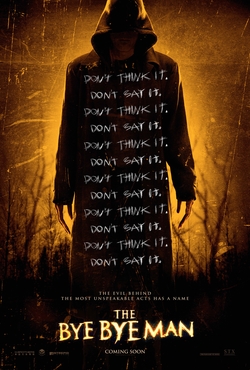Review: The Bye Bye Man May 22, 2016
Author: Beach Combing | in : Contemporary , trackback
Robert Damon Schneck, The Bye Bye Man and Other Strange-but-True-Tales (New York 2014)
RDS has built a reputation, in the last decade, for ‘strange stories’ well told with a strong bias towards the supernatural. This ‘new’ collection – actually originally published by Anomalist Press in 2005 as The President’s Vampire – has the typical RDS fare, tales from the seventeenth through twentieth century, involving the strange, the bloody strange and the unaccountably strange, put through the sieve of a careful mind; the author checks sources, questions assumptions and goes out and commendably makes a nuisance of himself with witnesses and their grandchildren. But it also includes a weird essay which gives the book its title: The Bye Bye Man. This essay is so atypical and long, sixty odd pages, that is deserves some space: the other essays are very much in the mould of RDS’s last collection of essays, reviewed here and as good.
The Bye Bye Man (henceforth BBM) was a monster who revealed himself through a Ouija board to three young adults in 1990. He was allegedly still alive (which makes him unique in the annals of spiritualism) and an albino serial killer with a sack of body parts called ‘the Gloomsinger’! The BBM, next, began to hunt the three young adults down and two of them had terrifying supernatural experiences. Then, the three grow up, get ‘proper’ jobs and the BBM disappears (or does he?!). This is a strange story, but RDS makes it stranger by trying to understand what actually happened in the claustrophobic room in which two men and a woman spent hours and hours contacting their own worst fears. There are, crudely speaking, three possibilities: first, BBM was the product of three fevered imaginations; second, BBM really existed and was coming to get ‘the kids’; or, third, and most intriguing the three created BBM who then took on an independent existence.
At this point it is necessary to introduce the protagonists. There was a woman Katherine, who had a long history of paranormal experiences and was sensibly wary of the Ouija board: Beach here invokes the Joe Bloggs vs Mystics rule in anomalies. There was John who had had some paranormal experiences. Then, there was, Katherine’s boyfriend, Eli who had never seen a ghost or anything else ‘strange’. Interestingly the Ouija board only gave communications when John and Katherine worked together. The spirits seem not to have liked Eli and shortly after the events described here Katherine left Eli and took up with John. Intriguing. The three also had, particularly, the two guys, an interest in folklore: ‘I [Eli] was studying both Anthropology and Folklore previously had done parapsychology work with O.B.E.’s at Stevens Point’ etc etc If they had been studying sociology they would have gone and blown up a government building, as it was they started talking to albino serial killers via the ethernet…
The paranormal experiences begin with a series of panic attacks: Katherine wakes up in the night terrified on many occasions; John too has disturbed nights. Then John and Katherine separately have a much stronger experience: in the case of John an impossible knock on the door in the dark; and, in the case of Katherine, a paranormal sound assault, let’s say. So what was this? Had the ‘kids’ (the Goonies all grown up) smoked too much weed? Do we live in a universe where albino serial killers communicate with their victims telepathically? And the tulpa idea, the notion that the kids give life to a supernatural monster? RDS is intrigued by this and describes the famous ‘Philip’ experiments from Toronto, where researchers created their own ghost. But, really, Beach is not convinced: RDS plants a mythological seed by hinting that a murder in 2001 was carried out by something like BBM, and he has had some success, there is now a BBM film! But back to facts…
The story is very, very effective on the page, but when you read it for the second time, you realize that the heart of the tale is actually vulnerable, as most ghost stories, to analysis. Explained in the simplest terms possible: John had a waking dream that involved audio stimuli (a very common phenomenon); and Katherine also had some form of audio whistling illusion, which Eli, who was with her, did not hear. As you go through the account these two events are frightening, but if isolated like this, they are rather unremarkable: they shrink in the test tube. When Beach was about fourteen there was a craze among the boys at school for forcing unconsciousness by breathing very deeply and then having friends press the heart of the breather with fists (unbelievable!!!), who naturally obliged their classmates by passing out. Eli, John and Katherine seems to have done something similar in psychological terms: they built up, with some foreknowledge, a head of angst and fear, and events, then, took their course. In narrative terms there is something satisfying about the fact that Eli (who tells the story) moves out and John and Katherine move, however briefly, into each other’s arms. They had created a human algebra, and as all good mathematicians they then reduced the numbers to their simplest terms.
Beach is always on the look out for excellent books: drbeachcombing At yahoo DOT com


